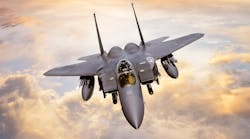BAE Starts Low-Rate Production of EPAWSS for Boeing
Armed with a $58 million contract from Boeing, BAE Systems has begun low-rate initial production (LRIP) of the F-15 Eagle Passive Active Warning and Survivability System (EPAWSS) for U.S. Air Force (USAF) fighter jets. The combination electronic-warfare (EW) and electronic-countermeasures (ECM) system is designed to provide reliable adversary detection and electronic protection for U.S. pilots under the most adverse environments.
“The start of EPAWSS production marks a critical milestone and is a testament to the dedication and commitment of our industry team,” said Jerry Wohletz, vice-president and general manager of Electronic Combat Solutions at BAE Systems. “Our technology is cutting-edge, our factories are world-class, and our people are innovative and mission-focused.” The EPAWSS integrates a variety of sensors, digital signal processing (DSP), artificial intelligence (AI), and self-protection functions to achieve highly accurate and sensitive radar warning in the most signal-congested environments. The USAF chose to proceed with the LRIP of the EPAWSS for the F-15 (see the figure) following successful completion of a series of flight tests, ground tests, and technology demonstrations to ensure the seamless interoperability of the many electronic subsystems within the complex EPAWSS.
“I’m proud of the overall team for their incredible effort on this program,” said F-15 EPAWSS program manager Lt. Col. Dan Carroll. “The LRIP milestone is the culmination of years of hard work by a lot of great people within the government and our Boeing and BAE Systems industry partners. EPAWSS will significantly improve the survivability and utility of the F-15 and will be a great complement to what is already a very capable and lethal aircraft.” Work on the EPAWSS program takes place at BAE Systems facilities in Nashua, NH; Austin, TX; and Totowa, NJ.
